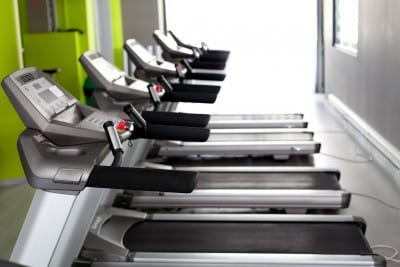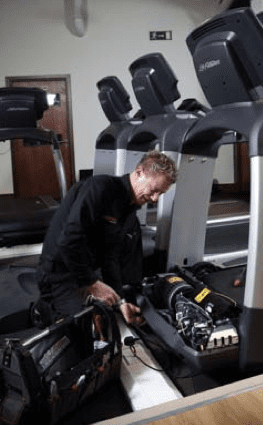SmartVan author Darren Weiss wrote a piece for Health Club Management magazine, a UK-based publication, focusing on health clubs and how they operate. So, how do health clubs and field service mix? Well, those expensive machines you work out on do break sometimes, and people have to come out and fix them. Here’s how a few gym equipment managers have used GPS and location-based devices and software to streamline their field operations. Reprinted with permission.
Since the first GPS units hit the consumer markets in the late 1990s, people have been fascinated with the concept that a tiny device in your car or your phone can sync to a satellite miles above the earth and determine your location within feet, all in the blink of an eye. In recent years, satellite tracking has gone a step further with geolocation, which uses GPS data to assess location and provides numerous dynamic capabilities.
 As is the case with most new technologies, geolocation reached the consumer market first. Location-based social services like Foursquare, Loopt and Gowalla rely on geolocation, and massive companies like Google and Facebook employ the technology for some of their services as well.
As is the case with most new technologies, geolocation reached the consumer market first. Location-based social services like Foursquare, Loopt and Gowalla rely on geolocation, and massive companies like Google and Facebook employ the technology for some of their services as well.
But shouldn’t such an innovative technology be used in more transformative ways than finding out the best restaurant in the West End? Couldn’t it be used by companies to drastically change how their workforce scheduling operates? The answer is yes – and it already is.
Driving Service Quality
Like their brethren in nearly all service industries, health club equipment service technicians have been stuck in the dark ages of technology for a long time, only recently dropping their clipboards, pens and Post-Its in favor of iPhones and tablets. But these new devices, with their state-of-the-art geolocation software, offer capabilities – delivering work orders on the go, real-time access to inventory, re-routing based on scheduling – that have a direct impact on a company’s bottom line and help improve efficiency and quality of service to their clients.
Today, a number of health club equipment manufacturers are actively using geolocation to optimize their entire service operation, from vehicle tracking and route guidance to real-time mobile communications and ordering spare parts on the fly, and the results have been impressive.
Precor, a fitness equipment manufacturer that sells its equipment all over the world, is a great example of a business that’s taking advantage of geolocation. Precor’s UK operation has a team of 17 mobile field service engineers, based from their homes, to cover the UK and Ireland. Each technician has his/her own van full of parts, and those vans are fitted with a vehicle tracking system that serves a number of purposes. When a service
call comes into the office, the dispatcher can scan the system for the closest service van to the customer site and send it out, minimizing the time between when the call comes in and when the technician arrives.
The tracking system also provides location awareness to give drivers updates on traffic and weather delays, logs driving speeds to mitigate inefficient driving, and tracks drive time and stop time. Additionally, managers can extract historical analysis from the system to check for excessive technician overlap.
Not all service calls are of equal importance and some must be prioritized. If your biggest client calls saying 100 of your machines in 15 clubs are not working, chances are you’re going to focus more resources on them than on the small club with a single stationary bicycle out of order.
Geolocation can play a key role here as well. Instead of adding less critical support calls onto an already busy technician’s schedule, geolocation software can search for the nearest available technician to that tier-two call and route him to the customer location. The software can then alert the customer via SMS, email or phone as to how far away the technician is. Imagine the satisfaction of telling your customer the service technician is exactly 10 minutes away instead of: “He should be there between 3.00pm and 6.00pm.”
Chris Hope, Precor’s UK service manager, has seen firsthand the advantages that geolocation can offer businesses. “We have instances where a club phones the Precor service desk to log a call, and because we send the job out in real-time to the closest technician, we can turn up within an hour or two of the club making the call,” he says. “I’ve had technicians contact me to say they have been to a site for a job that’s just come through on their PDA and the customer has said: ‘Wow! I only logged a call an hour ago and you have turned up already – that’s what I call service.’ It shows how this type of technology can improve both the efficiency of the technician and the service that the customer receives.”
On-site Support
Geolocation also assists service technicians when they are on-site. Life Fitness uses a geolocation system that has proved extremely helpful. While on a call, a technician will not always have every part needed for the job. Life Fitness technicians using geolocation can process parts orders at time of visit so that parts are requested same-day, resulting in a faster fix time and reducing potential equipment downtime. The ordered parts are electronically labelled with the order time and the customer’s location, ensuring they’re delivered to the right place as quickly as possible.
 Like Precor, the Life Fitness system also allows for real-time tracking and display of technician location and status, as well as more efficient driving routes – all of which makes life easier for both the service technicians and, most importantly, Life Fitness customers.
Like Precor, the Life Fitness system also allows for real-time tracking and display of technician location and status, as well as more efficient driving routes – all of which makes life easier for both the service technicians and, most importantly, Life Fitness customers.
“The speed of getting work quickly and accurately out to our field teams has already proved beneficial and has been particularly valuable when clients wish to request additional work while our technicians are already on-site,” says Margaret Vane, services manager for Life Fitness. “Geolocation enables us to spend more time adding real value to our service deliverables and focusing on what customers need from us. Having a fast, accurate way of sending and receiving data between service center and field was a critical factor in achieving a scalable, efficient and customer- orientated service delivery model.”
Securing Buy-in
Some see geolocation-based vehicle tracking systems as an invasion of privacy. Hope says Precor technicians had concerns at first, which the company did its best to assuage. “Initially there was a feeling among technicians that this was like a spy in the cab,” he says. “To minimize their concerns, the benefits of the system to both the company and the driver were explained, and the weekly summary reports obtained from the system are also sent by email to each of the technicians so that they can see exactly what the system is providing. A six-month period of settling in occurred before the system was accepted as part of the normal way of working, with the benefits appreciated by the technicians.”
Vane also recognised this need for buy-in from her teams at Life Fitness.
“To reduce the learning curve for our field teams, we introduced them to laptop-based technology around 12 months ahead of the system going live,” she says. “This provided them with valuable time to become accustomed to remotely locating data, service-specific and company information, as well as developing general data skills, before we transitioned to the new service model. It has already started to save technicians time every day.”
Still in its infancy, the benefits of geolocation to businesses are only just being realized. Geolocation is one of countless innovations reshaping how businesses function, reforming customer interactions and padding the bottom line for businesses. Its future capabilities remain to be seen, but they will no doubt serve to improve customer service and drive up profits.

Share this: